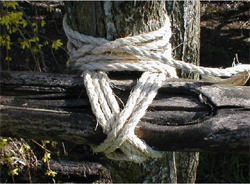Knots: Lashings - Sheer (or Shear) Lashing

Permission is granted to copy, distribute and/or modify this document under the terms of the GNU Free Documentation license, Version 1.2 or any later version published by the Free Software Foundation; with no Invariant Sections, no Front-Cover Texts, and no Back-Cover Texts.
Useful Links
Downloadable Guides
Introduction
A sheer lashing is often sued to bind adjacent poles together. It is also a good way to reinforce a broken or weak pole. The frapping turns used to tighten the lashing may be omitted and replaced with wedges inserted between the poles.
A loose Sheer Lashing made around the ends of two poles will allow the poles to be opened out and used as an A-frame. It can also be used to form a tripod just like the Figure-of-eight lashing.
Step by Step Guide
- Lay out the poles. For most lashings you will want to lay the poles side by side with the butt ends aligned (thicker ends).
- Tie a clove hitch around one of the outside poles and secure the standing part by wrapping it around the running part (or trap it under the first turns).
- Note: If you only lashing two poles together or are using the lashing to 'extend' a pole it may be better to simply tie the clove hitch around both poles and pull tight. Be sure to leave a long end on the Clove Hitch for the last step.
- Pass the rope around the poles to form a first turn.
- Pulling each turn tight made a series of turns until the lashing is at least as long as the combined diameters of the two poles (usually a set of 4 to 6 turns will be sufficient).
- Tighten the lashing with a frapping turn by taking the rope down between two poles at one end of the turns. This should be difficult to do if the turns have been pulled tightly (as they should be). Bring the rope back up between the poles at the other end of the lashing and pull tight. Repeat 2 or 3 times.
- Start the second set of frapping turns by taking the rope around the centre pole and frapping. Take the second set of frapping turns in the opposite direction to the first set.
- Repeat for any additional poles.
- Pass the rope once more between the poles then around one pole and tuck it under itself to form a half hitch. Pull this tight and make a second half hitch forming a clove hitch by taking the rope around the same pole and tucking it under itself.
- Once the final Clove Hitch is tied be sure to leave a 'long end'.
- Now tie a secure Reef Knot with the ends of the starting and finishing Clove Hitches. This should lie tightly across the lashing and should ensure that neither Clove Hitch works loose
- Notes on A-Frame Lashing: An A-frame lashing or Sheer Legs is made in the same way as a Sheer Lashing with the lashing and frapping turns made slightly loose so that the poles can be opened out. It is often used to raise a boat mast or to form the legs of a rope bridge. You must take care to ensure that the legs of the frame do not slip.
- Notes on Tripods: Make a tripod by using a Figure-of-eight lashing on three poles. Set up the tripod by crossing the outside poles so that the cross point of the poles is under the centre pole. This makes sure that part of the load is taken by the wood in contact.
- If a symmetrical arrangement of the poles is needed within a structure the tripod can be set up by rotating the poles around the lashing. This means that the load is supported only by the ropes and the joint becomes flexible and so the tripod may become unstable.